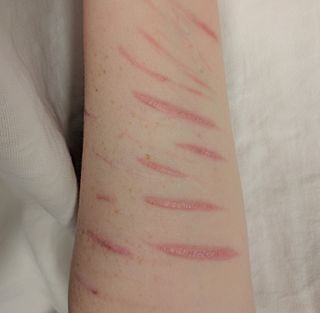
Self-harm is intentional conduct that is considered harmful to oneself. This is most commonly regarded as direct injury of one's own skin tissues usually without a suicidal intention. Other terms such as cutting, self-injury, and self-mutilation have been used for any self-harming behavior regardless of suicidal intent. Common forms of self-harm include damaging the skin with a sharp object or by scratching, hitting, or burning. The exact bounds of self-harm are imprecise, but generally exclude tissue damage that occurs as an unintended side-effect of eating disorders or substance abuse, as well as societally acceptable body modification such as tattoos and piercings.
Suicide is the second leading cause of death for people in the United States from the ages of 9 to 56.
A suicide method is any means by which a person may choose to end their life. Suicide attempts do not always result in death, and a non-fatal suicide attempt can leave the person with serious physical injuries, long-term health problems, and brain damage.

Suicide prevention is a collection of efforts to reduce the risk of suicide. Suicide is often preventable, and the efforts to prevent it may occur at the individual, relationship, community, and society level. Suicide is a serious public health problem that can have long-lasting effects on individuals, families, and communities. Preventing suicide requires strategies at all levels of society. This includes prevention and protective strategies for individuals, families, and communities. Suicide can be prevented by learning the warning signs, promoting prevention and resilience, and committing to social change.
Suicide intervention is a direct effort to prevent a person or persons from attempting to take their own life or lives intentionally.

Suicidal ideation, or suicidal thoughts, is the thought process of having ideas, or ruminations about the possibility of completing suicide. It is not a diagnosis but is a symptom of some mental disorders, use of certain psychoactive drugs, and can also occur in response to adverse life events without the presence of a mental disorder.

Suicidology is the scientific study of suicidal behaviour, the causes of suicidalness and suicide prevention. Every year, about one million people die by suicide, which is a mortality rate of sixteen per 100,000 or one death every forty seconds. Suicidologists believe that suicide is largely preventable with the right actions, knowledge about suicide, and a change in society's view of suicide to make it more acceptable to talk about suicide. There are many different fields and disciplines involved with suicidology, the two primary ones being psychology and sociology.
Suicide risk assessment is a process of estimating the likelihood for a person to attempt or die by suicide. The goal of a thorough risk assessment is to learn about the circumstances of an individual person with regard to suicide, including warning signs, risk factors, and protective factors. Risk for suicide is re-evaluated throughout the course of care to assess the patient's response to personal situational changes and clinical interventions. Accurate and defensible risk assessment requires a clinician to integrate a clinical judgment with the latest evidence-based practice, although accurate prediction of low base rate events, such as suicide, is inherently difficult and prone to false positives.
Youth suicide is when a young person, generally categorized as someone below the legal age of majority, deliberately ends their own life. Rates of youth suicide and attempted youth suicide in Western societies and other countries are high. Youth suicide attempts are more common among girls, but adolescent males are the ones who usually carry out suicide. Suicide rates in youths have nearly tripled between the 1960s and 1980s. For example, in Australia suicide is second only to motor vehicle accidents as its leading cause of death for people aged 15 to 25.

Suicide is the act of intentionally causing one's own death. Mental disorders, physical disorders, and substance abuse are risk factors. Some suicides are impulsive acts due to stress, relationship problems, or harassment and bullying. Those who have previously attempted suicide are at a higher risk for future attempts. Effective suicide prevention efforts include limiting access to methods of suicide such as firearms, drugs, and poisons; treating mental disorders and substance abuse; careful media reporting about suicide; improving economic conditions; and dialectical behaviour therapy (DBT). Although crisis hotlines are common resources, their effectiveness has not been well studied.

Gender differences in suicide rates have been shown to be significant. There are different rates of suicides and suicidal behavior between males and females. While females more often have suicidal thoughts, males die by suicide more frequently. This discrepancy is also known as the gender paradox in suicide.

IS PATH WARM? is an acronym utilized as a mnemonic device. It was created by the American Association of Suicidology to help counselors and the general public "remember the warning signs of suicide."
Researchers study Social media and suicide to find if a correlation exists between the two. Some research has shown that there may be a correlation.
Historically, suicide terminology has been rife with issues of nomenclature, connotation, and outcomes, and terminology describing suicide has often been defined differently depending on the purpose of the definition. A lack of agreed-upon nomenclature and operational definitions has complicated understanding. In 2007, attempts were made to reach some consensus. There is also opposition to the phrase "to commit suicide" as implying negative moral judgment and association with criminal or sinful activity.
In 2014, the WHO ranked Nepal as the 7th in the global suicide rate. The estimated annual suicides in Nepal are 6,840 or 24.9 suicides per 100,000 people. Data on suicide in Nepal are primarily based on police reports and therefore rely on mortality statistics. However, the burden of suicide in communities is likely to be higher, particularly among women, migrant workers, and populations affected by disasters.
In colleges and universities in the United States, suicide is one of the most common causes of death among students. Each year, approximately 24,000 college students attempt suicide while 1,100 students succeed in their attempt, making suicide the second-leading cause of death among U.S. college students. Roughly 12% of college students report the occurrence of suicide ideation during their first four years in college, with 2.6% percent reporting persistent suicide ideation. 65% of college students reported that they knew someone who has either attempted or died by suicide, showing that the majority of students on college campuses are exposed to suicide or suicidal attempts.
Suicide awareness is a proactive effort to raise awareness around suicidal behaviors. It is focused on reducing social stigmas and ambiguity by bringing attention to suicide statistically and sociologically, and by encouraging positive dialogue and engagement to prevent suicide. Suicide awareness is linked to suicide prevention as both address suicide education and the dissemination of information to ultimately decrease the rate of suicide. Awareness is the first stage that can ease the need for prevention. Awareness signifies a fundamental consciousness of the threat, while prevention focuses on stopping the act. Suicide awareness is not a medical engagement but a combination of medical, social, emotional and financial counseling. Suicide awareness in adolescents focuses on the age group between 10–24 years, beginning with the onset of puberty.
Suicide and trauma is the increased risk of suicide that is caused by psychological trauma.
Youth suicide in India is when young Indian people deliberately end their own life. People aged 15 to 24 years have the highest suicide rate in India, which is consistent with international trends in youth suicide. 35% of recorded suicides in India occur in this age group. Risk factors and methods of youth suicide differ from those in other age groups.
David A. Jobes is an American clinical psychologist. He is currently serving as a Professor of Psychology, Director of the Suicide Prevention Laboratory, and Associate Director of Clinical Training at The Catholic University of America. His areas of focus are on Clinical psychology, Suicide prevention, Clinical Suicidology, Ethics and Risk Management, and clinical risk assessment. In August 2022, he was awarded the Alfred Wellner Award for Lifetime Achievement by The National Register of Health Service Psychologists.






